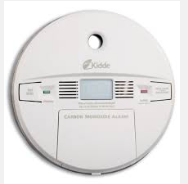Rental Properties in Pennsylvania are Required to Have Operating Carbon Monoxide Detectors
Posted By Cliff Tuttle | June 6, 2016
No. 1,260
Carbon Monoxide Alarm Standards Act
35 P.S. § 7221 – 7227 (Current through 12/18/2013) (When referring to section numbers, use the last digit of each section. For example, 25 P.S. §7222 might be referred to as Section 2 of the Act)
TABLE OF CONTENTS
Short title
Definitions
Administration
Carbon monoxide alarm requirements
Carbon monoxide alarm requirements in rental properties Enforcement
Municipal Requirements
Short title
This act shall be known and may be cited as the Carbon Monoxide Alarm Standards Act.
§ 7222. Definitions
The following words and phrases when used in this act shall have the meanings given to them in this section unless the context clearly indicates otherwise:
“APARTMENT.” A room or suite of two or more rooms, occupied or leased for occupation, or intended or designed to be occupied, as a domicile.
“APPROVED CARBON MONOXIDE ALARM.” The term includes:
(1) A single or multiple station carbon monoxide alarm listed as complying with the Approved American National Standard for Single and Multiple Station Carbon Monoxide Alarms (ANSI/UL2034) or a carbon monoxide detector listed as complying with the Approved American National Standard for Gas and Vapor Detectors and Sensors (AN- SI/UL2075) installed in accordance with this act.
(2) A device that may be combined with a smoke alarm or smoke detector if the combined smoke alarm or detector meets all of the following:
(i) Complies with either of the following:
(A) The Approved American National Standard for Single and Multiple Station Carbon Monoxide Alarms (AN- SI/UL2034) for carbon monoxide alarms and the Approved American National Standard for Single and Multiple Station Smoke Alarms (ANSI/UL217) for smoke alarms.
(B) The Approved American National Standard for Gas and Vapor Detectors and Sensors (ANSI/UL2075) for carbon monoxide detectors and the Approved American National Standard for Safety for Smoke Detectors for Fire Alarm Systems (ANSI/UL268) for smoke detectors.
(ii) Emits an alarm in a manner that clearly differentiates between detecting the presence of carbon monoxide and the presence of smoke.
(3) A carbon monoxide detection system that includes carbon monoxide detectors and audible notification appliances that are installed and maintained in accordance with the National Fire Alarm and Signaling Code (NFPA 72) and the Standard for the Installation of Carbon Monoxide (CO) Detection and Warning Equipment (NFPA 720) and are in compliance with the Approved American National Standard for Gas and Vapor Detectors and Sensors (ANSI/UL2075).
“FOSSIL FUEL.” Coal, kerosene, oil, wood, fuel gases and other petroleum or hydrocarbon products which emit carbon monoxide as a by-product of combustion.
“INSTALLED.” A carbon monoxide alarm that is hardwired into the electrical wiring, directly plugged into an elec- trical outlet without a switch, other than a circuit breaker, or, if the alarm is battery powered, attached to the wall or ceiling of a residential building, an apartment or a multifamily dwelling, in accordance with the standard for the instal- lation of carbon monoxide (CO) detection and warning equipment (NFPA 720).
“MULTIFAMILY DWELLING.” Any house or building, or portion thereof, that is intended or designed to be occu- pied or leased for occupation, or occupied as a home or residence for three or more households living in separate apart- ments, and doing their cooking on the premises.
“OPERATIONAL.” Working and in service.
“RESIDENTIAL BUILDING.” Detached one-family and two-family dwellings and multiple single-family dwellings which are not more than three stories in height with a separate means of egress, which includes accessory structures.
§ 7223. Administration
Nothing in this act is intended to modify the authority and responsibilities of the Department of Labor and Industry under the act of November 10, 1999 (P.L. 491, No. 45), known as the Pennsylvania Construction Code Act.
§ 7224. Carbon monoxide alarm requirements
(a) RESIDENTIAL BUILDING.– Upon the sale of a residential building, the seller shall disclose information re- garding the installation of carbon monoxide detectors on the property disclosure statement required by 68 Pa.C.S. Ch. 73 (relating to seller disclosures).
(b) MULTIFAMILY DWELLINGS.– Each apartment in a multifamily dwelling, which uses a fossil fuel-burning heater or appliance, fireplace, or an attached garage, must have an operational, centrally located and approved carbon monoxide alarm installed in the vicinity of the bedrooms and the fossil fuel-burning heater or fireplace within 18 months of the effective date of this act.
§ 7225. Carbon monoxide alarm requirements in rental properties
(a) OWNER RESPONSIBILITIES.– The owner of a multifamily dwelling having a fossil fuel-burning heater or appliance, fireplace or an attached garage used for rental purposes and required to be equipped with one or more ap- proved carbon monoxide alarms shall:
(1) Provide and install an operational, centrally located and approved carbon monoxide alarm in the vicinity of the bedrooms and the fossil fuel-burning heater or fireplace.
(2) Replace, in accordance with this act, any approved carbon monoxide alarm that has been stolen, removed, found missing or rendered inoperable during a prior occupancy of the rental property and which has not been replaced by the prior occupant before the commencement of a new occupancy of the rental property.
(3) Ensure that the batteries in each approved carbon monoxide alarm are in operating condition at the time the new occupant takes residence in the rental property.
(b) MAINTENANCE, REPAIR OR REPLACEMENT.– Except as provided in subsection (a), the owner of a multi- family dwelling used for rental purposes is not responsible for the maintenance, repair or replacement of an approved carbon monoxide alarm or the care and replacement of batteries while the building is occupied. Responsibility for maintenance and repair of carbon monoxide alarms shall revert to the owner of the building upon vacancy of the rental property.
(c) OCCUPANT RESPONSIBILITIES.– The occupant of each multifamily dwelling used for rental purposes in which an operational and approved carbon monoxide alarm has been provided must:
(1) Keep and maintain the device in good repair.
(2) Test the device.
(3) Replace batteries as needed.
(4) Replace any device that is stolen, removed, missing or rendered inoperable during the occupancy of the building.
(5) Notify the owner or the authorized agent of the owner in writing of any deficiencies pertaining to the approved carbon monoxide alarm.
§ 7226. Enforcement
Willful failure to install or maintain in operating condition any approved carbon monoxide alarm required by this act is a summary offense punishable by a fine of up to $ 50.
§ 7227. Municipal requirements
Nothing in this act shall be construed to prevent a municipality from adopting, by resolution, equal or more stringent requirements relating to carbon monoxide alarms.
Tags: CO > CO Detectors




